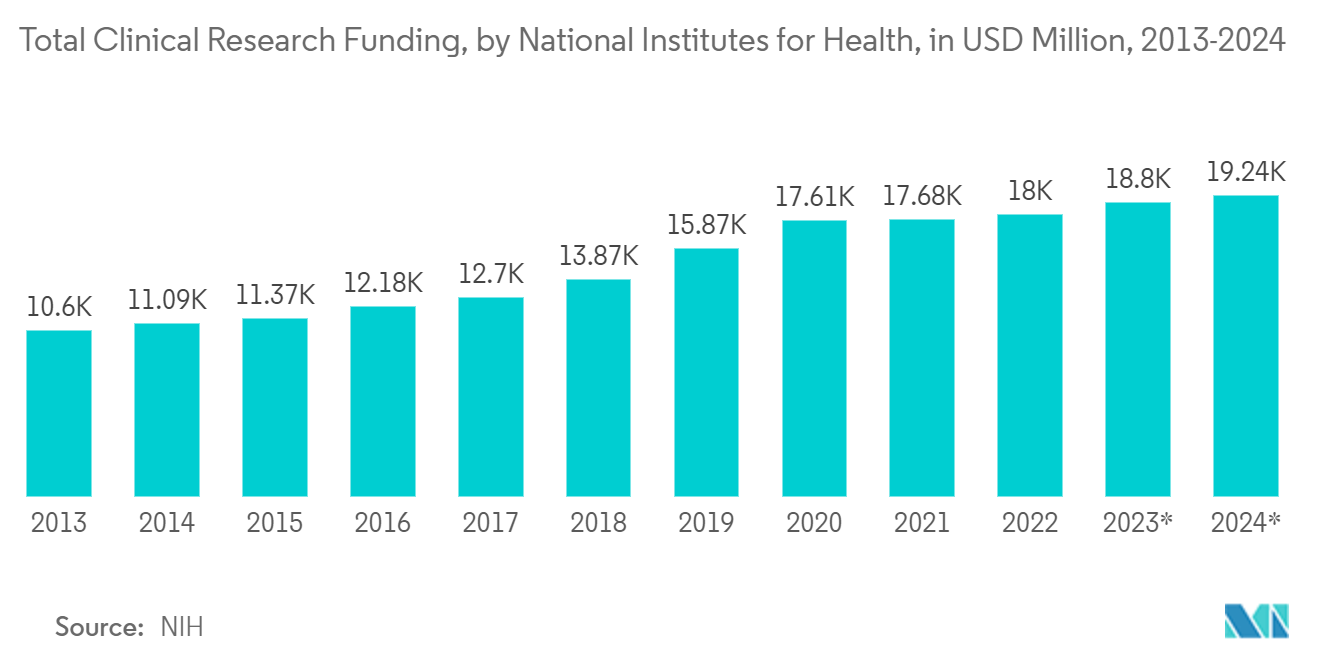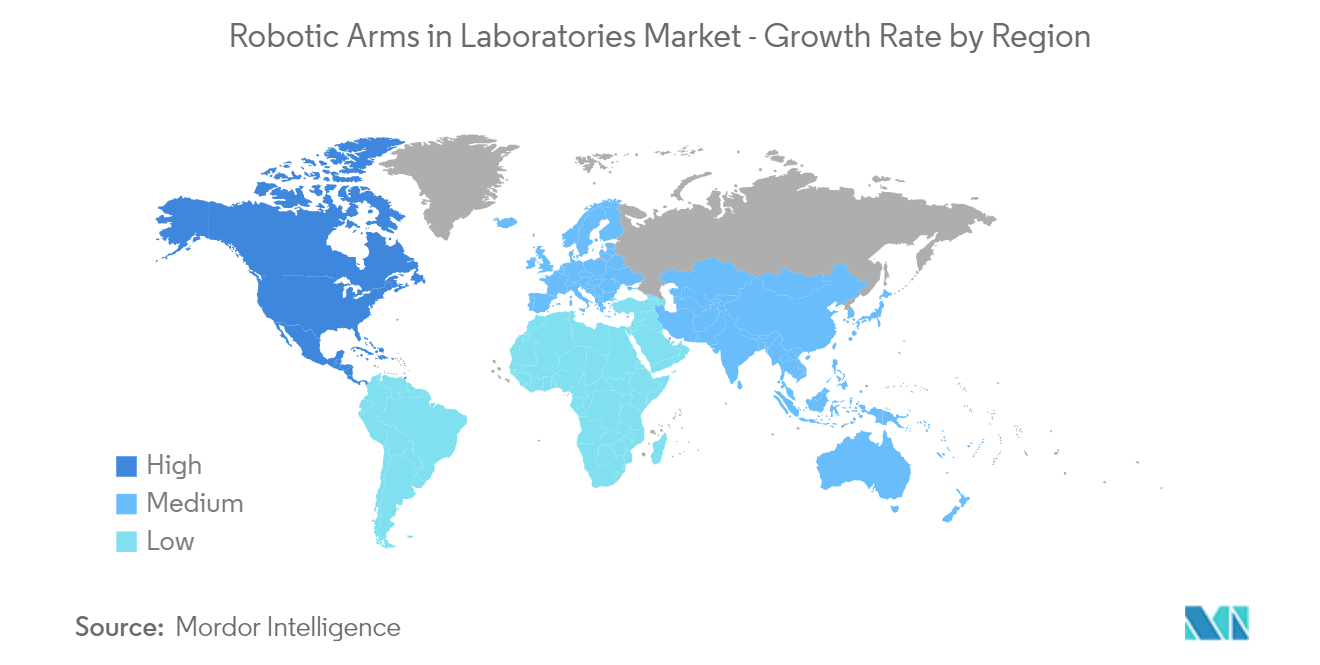Market Trends of Robotic Arms In Laboratories Industry
Genomics and Proteomics Application is Expected to Hold Significant Market Share
- Genomics refers to the study of whole genomes of organisms while incorporating elements from genetics. Scientists always look for improved accuracy, higher throughput, and reduced cost during advanced gene sequencing. Though most labs lack access, automation has often delivered all these.
- With the technological advancements, increasing investments in clinical research, and computational capacities over the past few years, there has been significant improvement in knowledge of genome sequencing in terms of data analytics advances that show unknown correlations, hidden patterns, and other insights, specifically when testing data sets on a large scale. Moreover, novel medical advances are being made rapidly, mainly due to recent developments in genome analysis. DNA sequence analysis provides a clearer understanding of how genetic variation leads to disease and, thus, will lead to new cures. According to NIH, clinical research funding by the National Institute of Health was USD 18 billion.
- Furthermore, laboratory automation has made room for great flexibility, higher throughputs, and affordable solutions. It offers faster handling, and the process can be expedited without worrying about a lack of reliability and precision. Genotyping and DNA sequencing have been affordable, and the growth rate is robust. Some instruments can automate nearly every step of the large-scale sequencing process: isolating DNA, cloning or amplifying DNA, preparing enzymatic sequencing reactions, purifying DNA, and separating and detecting DNA fragments with fluorescent labels to obtain DNA sequences.
- Although genomics has the potential to increase medicine efficacy and speed up precision healthcare, one of the most promising areas is the introduction of genetic testing into clinical trials. With breakthroughs in science and growing awareness of the effect of genomics, there is a need and an opportunity to maximize the value of the gathered samples and the data generated from them. As a result, obtaining genetic samples is extensively urged at all phases and studies of clinical development.
- In April 2022, INSACOG (Indian SARS-CoV-2 Consortium on Genomics), a group of 38 genome sequencing institutes in India, published a report in which it was estimated that India sequenced 89,860 samples between January and April. There are now 240,570 sequenced samples in total. Only 0.397 percent of India's total cases have been sequenced. According to the most recent data from the Global Initiative on Sharing Avian Influenza Data (GISAID), the world's most extensive database of new coronavirus genome sequences, this is the case. Using genomics will enable the identification of the pattern of the virus and prevent future mutation spread. The increasing need for Genomics & Proteomics is anticipated to be a lucrative opportunity for the studied market's growth.
- Furthermore, nucleic acid isolation, RNAi screening, CRISPR analysis, PCR, and gene expression analysis are just a few of the genomics applications that use automation. Laboratory automation players/vendors are developing tools to meet these application requirements. Tecan Group, for example, recently introduced their new "Fluent Automation Workstation" platform, which incorporates various capabilities to simplify day-to-day laboratory automation and increase workflow productivity. The technique reacts dynamically during a run, making adjustments based on actual times to maintain continuous optimal throughput, visible in real time via an easy-to-understand Gantt chart.

North America is Expected to Hold the Significant Market Share
- The United States has been a pioneer in clinical research for years. This country is home to major pharmaceutical companies, like Pfizer, Novartis, GlaxoSmithKline, J&J, and Novartis. The government also has the highest concentration of contract research organizations (CROs). Some of the significant CROs in the country are Laboratory Corp. of America Holdings, IQVIA, SyneosHealth, and Parexel International Corp.
- Owing to the presence of all the major players in the industry and stringent FDA regulations, the market is very competitive in the country. Companies in the country are increasingly adopting robotics and automation in labs to gain an advantage over competitors.
- In February 2022, Auris Health and Kinova agreed to a five-year contract extension. In accordance with the deal, Kinovawould keep assisting Auris in growing its Monarch Platform, which is intended for robotic-assisted surgery. An option to prolong the relationship for a further three years is part of the agreement. To define and create a purpose-built robotic arm to support substantial advancement in surgery, the team at Auris collaborated with Kinova, a Canadian business specializing in robotic arms. The Monarch Platform is intended for therapeutic and diagnostic bronchoscopic operations.
- In addition, Duke University engineers and ophthalmologists recently created robotic imaging equipment that can automatically identify and scan a patient's eyes for signs of various eye illnesses. The new device, which combines a robotic arm and an imaging scanner, can automatically track and picture a patient's eyes in less than a minute and generate images as clear as those from conventional scanners used in specialized eye clinics. Such expansion of innovative products in the country may further drive the studied market growth.
- In addition, the country has the most significant number of contract research organizations (CROs). Syneos Health, IQVIA, Laboratory Corp. of America Holdings, and Parexel International Corp. are among the country's largest CROs. The market in the nation is exceptionally competitive, thanks to the presence of all of the main competitors in the business and strict FDA rules. Companies in the country are rapidly using robots and automation in labs to get a competitive advantage over competitors. According to ClinicalTrials.gov, incorporating robots and automation has been a critical component assisting the development of the clinical research sector, with more than 129,005 clinical trials filed in the United States recently. Furthermore, due to the growing adoption of robots and automation, there has been a considerable increase in FDA approvals in recent years.

